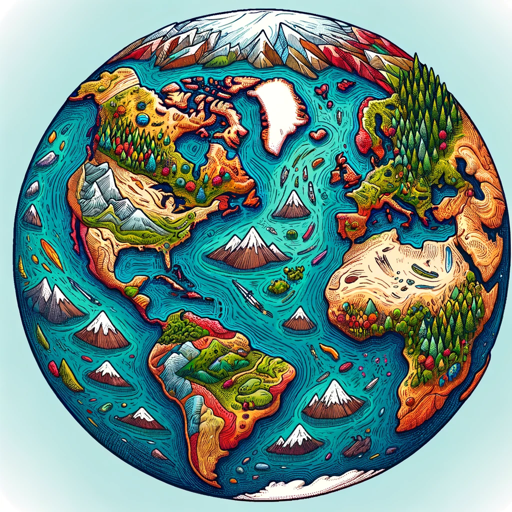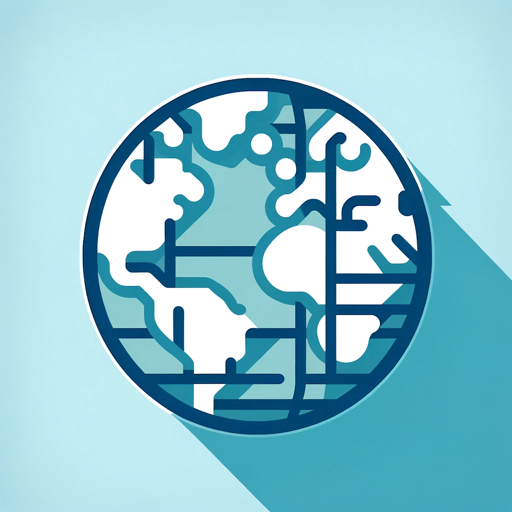GeoGPT-AI-powered map creation tool
AI-powered map customization at your fingertips
I want to build a map!
Generate a random map!
Related Tools
Load More
EarthGPT - Maps, Satellite Images, Geography
Explore planet earth using maps and satellite images right within ChatGPT.

GeoGPT
A scholarly geography resource with extensive knowledge from books and papers.

.GPT NEO
Direct, helpful, and clear answers with minimal fluff

GIS MAPPING - GPT
Leading AI Agent resource in geographic information system (GIS), offering comprehensive knowledge, insights, and guidance of integrated computer hardware and software that store, manage, analyze and visualize geographic data. https://gismapping.ai

GIS GPT
Expert in GIS, guiding users through learning, troubleshooting, automation and practical applications.

Geology GPT
Explore geology's secrets with Geology GPT, your personal guide to Earth's wonders!
20.0 / 5 (200 votes)
Introduction to GeoGPT
GeoGPT is an AI-powered assistant designed to help users create, customize, and visualize maps using the Mapbox platform. It leverages natural language processing to interpret user requests and transform them into functional web map configurations, making the process of map creation more intuitive and accessible, even for those without technical expertise. GeoGPT's primary function is to facilitate the creation of web maps by guiding users through each step, ensuring that their desired outcomes are accurately translated into map visualizations. It can generate static map images, handle dynamic customization requests, and provide users with previews, making it a versatile tool for anyone looking to create maps for various purposes. For example, if a user wants to create a map that highlights tourist attractions in Paris, GeoGPT can guide them through adding markers, adjusting map styles, and even setting the zoom level to provide a clear view of the area, ultimately producing a map that meets the user's specific needs.

Core Functions of GeoGPT
Static Image Generation
Example
A travel blogger wants to include a map showing their recent trip route across Europe in a blog post. They request GeoGPT to generate a static map centered on major European cities they visited.
Scenario
GeoGPT processes the request and uses the Mapbox Static Image API to create a map preview centered on the specified cities. This allows the blogger to quickly visualize their trip without requiring in-depth technical knowledge of mapping tools.
Interactive Map Creation
Example
An urban planner needs an interactive map to visualize different zoning areas within a city. They describe their requirements to GeoGPT, such as the city's boundaries, zoning categories, and preferred map styles.
Scenario
GeoGPT uses the Mapbox platform to create an interactive web map, allowing the planner to explore zoning areas by panning and zooming. The planner can then share this map with colleagues or stakeholders, facilitating discussions and decision-making.
Custom Marker Placement
Example
A real estate agent wants to showcase available properties across different neighborhoods in a city. They ask GeoGPT to place custom markers on the map for each property location, with different icons representing different property types (e.g., houses, apartments, offices).
Scenario
GeoGPT places markers at the specified locations and provides the agent with a customized map that highlights all properties. This map can be embedded on the agent's website or shared with clients, helping them easily visualize the available options.
Target User Groups for GeoGPT
Businesses and Professionals
Businesses in fields such as real estate, tourism, logistics, and urban planning can significantly benefit from GeoGPT. For instance, real estate professionals can create maps showcasing properties, logistics companies can visualize delivery routes, and urban planners can explore zoning plans. These users often need detailed and interactive maps to share with clients or team members, making GeoGPT's ability to provide quick, customizable maps a valuable asset for their operations.
Educators and Researchers
Educators and researchers who need to create maps for presentations, reports, or classroom activities can leverage GeoGPT to generate accurate and visually appealing maps. For example, a geography teacher could use GeoGPT to create maps that illustrate different climate zones for a lesson, while a researcher might generate maps that show population density changes over time for a study. GeoGPT simplifies the map creation process, enabling these users to focus more on their core tasks rather than the technicalities of map design.

How to Use GeoGPT
1
Visit aichatonline.org for a free trial without login, also no need for ChatGPT Plus. Get started immediately with no hassle.
2
Once on the platform, initiate a session by providing your Mapbox API token. This is essential for creating and customizing maps tailored to your needs.
3
Specify your map requirements: GeoGPT can help you design various map types, whether it’s for data visualization, geographic analysis, or personal navigation.
4
Preview and adjust: GeoGPT will generate a static image link for you to preview. Modify parameters like map style, zoom levels, or add markers as needed.
5
Iterate and finalize: Continue refining your map design based on your project’s needs, then export the final map or integrate it into your application.
Try other advanced and practical GPTs
CyberGPT
AI-Powered Assistant for Cybersecurity Insights

猫猫视频图像处理
AI-powered tool for detailed image prompts.

Pixarify Me - Kids Movie Animation Style
Transform your photos into Pixar-style animations with AI.

ゆっくり解説動画シナリオGPT
AI-powered script generator for ゆっくり解説動画

企画〜動画投稿(長尺動画出力)
AI-powered video script creation made easy.

LeetCoder Genius
AI-powered coding assistant for emerging software engineers.

PowerShell Codex
AI-powered PowerShell scripting tool.

口播达人
AI-powered creativity, no limits

TEST: Partnership Activity Summary 2.0
AI-powered summaries for strategic partnerships.

The Viking Leadership Coach
AI-Powered Leadership Insights

IEP ASSISTANT OFFICAL ✔️
AI-driven tool for personalized IEPs.

Canadian Accountant GPT (CPA, ASPE, IFRS)
AI-powered insights for Canadian accountants

- Data Visualization
- Navigation
- Urban Planning
- Map Design
- Geographic Analysis
Top 5 Questions About GeoGPT
How can GeoGPT help with custom map creation?
GeoGPT is designed to assist users in creating interactive or static maps using Mapbox. From styling choices to custom zoom levels, it provides an intuitive way to generate personalized maps for any use case.
Do I need to be a technical expert to use GeoGPT?
No, GeoGPT simplifies the map-building process. You don't need to be a developer; simply provide your requirements, and GeoGPT will guide you through the rest, including generating preview links for immediate review.
What kind of maps can I create with GeoGPT?
GeoGPT allows you to create a wide range of maps, such as topographic maps, street maps, or satellite imagery, for diverse purposes like academic research, business intelligence, or personal projects.
Can I add custom markers and labels to my map?
Yes, GeoGPT supports adding custom markers, labels, and data points to maps. You can also control other elements like map zoom, center points, and overlays to suit your project.
What are the main benefits of using GeoGPT?
GeoGPT offers a seamless, user-friendly interface for creating highly customized maps, saving time and effort. It's ideal for professionals, researchers, and developers who need specific maps without diving into complex coding.